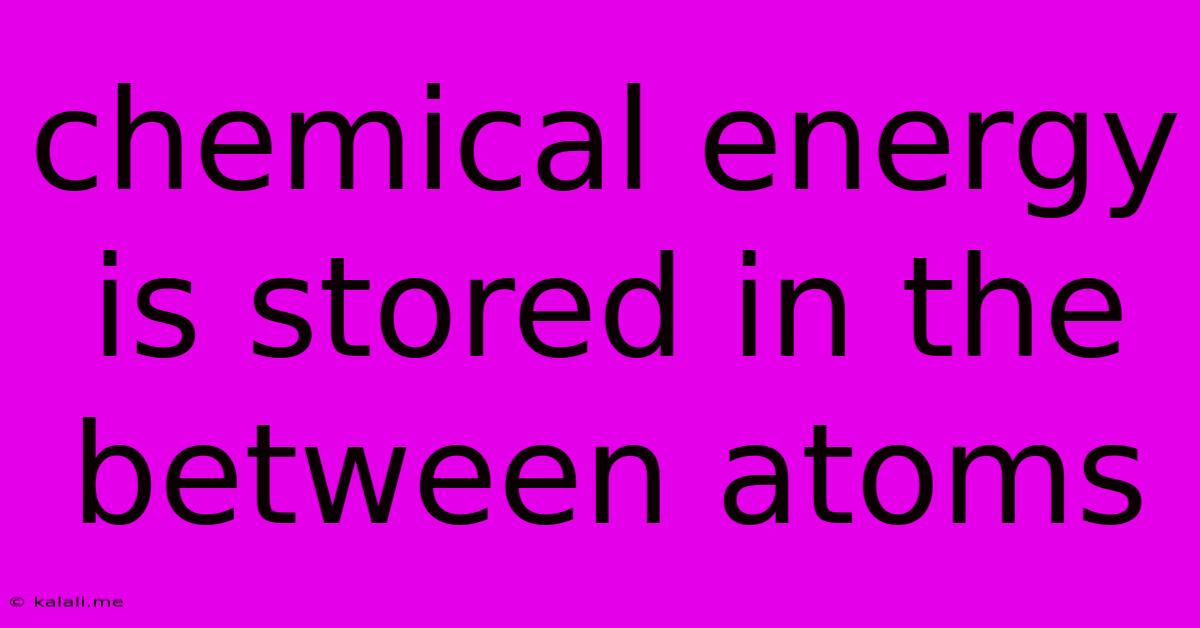Chemical Energy Is Stored In The Between Atoms
Kalali
Jun 16, 2025 · 3 min read

Table of Contents
Chemical Energy: The Hidden Power Between Atoms
Chemical energy, the energy stored within the bonds of atoms and molecules, is the driving force behind countless processes in the world around us. From the combustion of gasoline in your car to the complex metabolic reactions within your body, understanding how this energy is stored and released is crucial. This article delves into the fascinating world of chemical energy, explaining its origins and how it's harnessed for various applications.
What is Chemical Energy?
Chemical energy is a form of potential energy, meaning it's stored energy that has the potential to be released and converted into other forms of energy, such as kinetic energy (motion), thermal energy (heat), or light. This energy is specifically stored in the chemical bonds that hold atoms together to form molecules. The strength and arrangement of these bonds dictate the amount of chemical energy a substance possesses. Stronger bonds generally imply greater energy storage.
The Role of Electrons and Atomic Structure
At the heart of chemical energy lies the behavior of electrons. Electrons orbit the nucleus of an atom in specific energy levels or shells. When atoms combine to form molecules, electrons are shared or transferred between them, forming chemical bonds. This rearrangement of electrons leads to a change in the overall energy of the system. The energy difference between the reactants (initial substances) and products (resulting substances) determines the amount of chemical energy released or absorbed during a chemical reaction.
Types of Chemical Bonds and Energy Storage
Several types of chemical bonds contribute to the storage of chemical energy:
-
Covalent Bonds: These bonds involve the sharing of electrons between atoms. The strength of the covalent bond depends on the types of atoms involved and the number of electrons shared. Molecules like water (H₂O) and methane (CH₄) exhibit strong covalent bonds, storing significant chemical energy.
-
Ionic Bonds: Ionic bonds arise from the electrostatic attraction between oppositely charged ions. One atom donates an electron(s) to another, creating a positive and negative ion that are then attracted to each other. Table salt (NaCl) is a classic example of a compound with ionic bonds, possessing considerable chemical energy.
-
Metallic Bonds: In metals, electrons are delocalized, meaning they're not associated with a specific atom but rather move freely throughout the metal lattice. This contributes to the unique properties of metals, such as their conductivity and malleability, and results in a significant amount of stored chemical energy.
Releasing Chemical Energy: Exothermic and Endothermic Reactions
Chemical reactions can either release or absorb energy.
-
Exothermic Reactions: These reactions release energy to their surroundings, often in the form of heat or light. Combustion is a prime example – burning wood or fuel releases stored chemical energy as heat and light. The bonds in the products are stronger than those in the reactants, resulting in a net release of energy.
-
Endothermic Reactions: These reactions absorb energy from their surroundings. Photosynthesis is a classic example; plants absorb sunlight to convert carbon dioxide and water into glucose, storing energy in the chemical bonds of the glucose molecule. The bonds in the products are weaker than those in the reactants.
Applications of Chemical Energy
Chemical energy plays a pivotal role in many aspects of modern life:
-
Fuel Sources: Fossil fuels (coal, oil, and natural gas) store vast amounts of chemical energy, providing energy for transportation, electricity generation, and heating.
-
Batteries: Batteries store chemical energy and release it as electrical energy, powering electronic devices.
-
Food: The food we eat contains chemical energy that our bodies use for various functions, such as movement and growth.
Conclusion
Chemical energy, stored within the intricate network of atomic bonds, is a fundamental force shaping our world. By understanding how electrons arrange themselves and form bonds, we can better appreciate the incredible power residing between atoms and unlock its potential for various applications. Further research into enhancing energy storage and efficient energy conversion from chemical sources remains crucial for a sustainable future.
Latest Posts
Latest Posts
-
How To Create Clickable Image In Html
Jun 16, 2025
-
What Are The Factors Of 121
Jun 16, 2025
-
What Is A Theme Of The Passage
Jun 16, 2025
-
A Company That Provides Access To The Internet
Jun 16, 2025
-
Which Word Is Closest In Meaning To The Underlined Word
Jun 16, 2025
Related Post
Thank you for visiting our website which covers about Chemical Energy Is Stored In The Between Atoms . We hope the information provided has been useful to you. Feel free to contact us if you have any questions or need further assistance. See you next time and don't miss to bookmark.